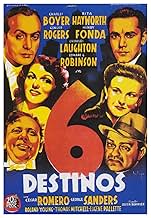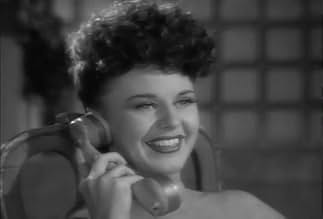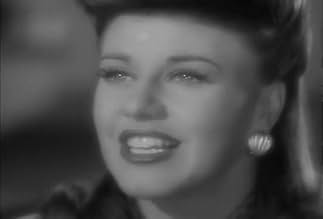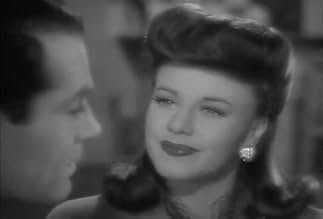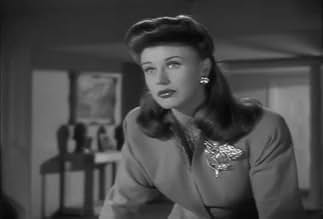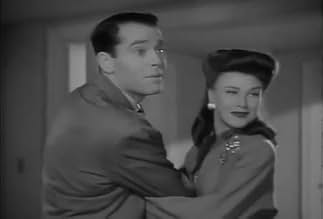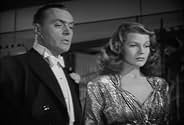IMDb-BEWERTUNG
7,3/10
2693
IHRE BEWERTUNG
Füge eine Handlung in deiner Sprache hinzuA formal tailcoat that gets passed from one owner to another affects each life in a significant way.A formal tailcoat that gets passed from one owner to another affects each life in a significant way.A formal tailcoat that gets passed from one owner to another affects each life in a significant way.
- Auszeichnungen
- 7 wins total
Empfohlene Bewertungen
For a brief period in cinema history, the anthology film was all the rage. Movies like "Flesh and Fantasy" and "O. Henry's Full House" used large casts to tell several interlocked stories. "Tales of Manhattan" is the best of the anthology films, following the adventures of a tuxedo's tailcoat as it passes through the hands of several diverse people in New York. There's Charles Boyer, the Broadway actor who is carrying on an illicit affair; there's Henry Fonda who is helping Cesar Romero get out of a sticky situation with his fiancee Ginger Rogers (along the way, Fonda and Rogers fall in love and have one of the best-written love scenes to ever hit the screen); there's Charles Laughton who seeks one shot at glory conducting an orchestra; and, in the most touching and rewarding of the tales, there's Edward G. Robinson, a down-and-out bum who has been invited to his college reunion. If you're looking for an all-star cast and a first-rate cinema experience, "Tales of Manhattan" is the one. I consistently put this movie at the top of my all-time favorites.
The movements of an accursed tail coat about the Big City, and the lives of those who use it, becomes part of the TALES OF MANHATTAN.
Fox Studios and director Julien Duvivier fashioned this most enjoyable film. The idea of the tail coat never becomes silly or gets in the way of the plot, which doles out equal amounts of irony, suspense, pathos & comedy. The all-star cast gives worthy performances which keeps the viewer's attention right to the very end.
SEQUENCE ONE An actor and his lover (Charles Boyer & Rita Hayworth) are confronted by her quietly sadistic husband (Thomas Mitchell). Eugene Palette plays Boyer's loyal valet. An unbilled Robert Greig appears as the corpulent creator of the elegant tail coat.
Most of the action in this sequence takes place at an estate outside of Manhattan.
SEQUENCE TWO A shy fellow (Henry Fonda) tries to help his friend (Cesar Romero) out of a jam with his suspicious fiancé (Ginger Rogers). Gail Patrick appears as Rogers' nosy gal pal; Roland Young plays Romero's protective valet.
A quite different tail coat is the center of the plot here, which can become a bit confusing.
SEQUENCE THREE A poor composer (Charles Laughton) finally has the opportunity to conduct his magnum opus at a concert. Radiant Elsa Lanchester appears as Laughton's adoring wife. Christian Rub plays a friendly cellist, while Victor Francen is very believable as the noble Bellini. An unbilled Dewey Robinson plays the bullying owner of a small café.
Laughton is magnificent, as is to be expected, giving another master class in how to turn a small part into something very special.
SEQUENCE FOUR
After being spiffed-up and accoutered in the tail coat, a skid row bum (Edward G. Robinson) makes a poignant appearance at the Waldorf-Astoria for his college's 25-year class reunion. James Gleason plays the kindly parson who runs a rescue mission; silent screen star Mae Marsh appears as his sweet-natured wife. Harry Davenport appears as a wise old professor; George Sanders snarls his way through his role as Robinson's old antagonist.
Robinson & Gleason do some impressive acting, making their characters come alive.
SEQUENCE FIVE
An eccentric professor (W.C. Fields) gives a temperance lecture to a gathering of high society swells, not knowing that the coconut milk has been liberally spiked. Phil Silvers shines in the brief role of the secondhand dealer who sells the tail coat to Fields. The monumental Margaret Dumont enlivens her scant appearance as the matron sponsoring Fields.
Before the film's initial release, there was consternation from some of the other major stars concerning Fields' large salary. The clamor grew to the point that Fox weaseled out by simply excising the sequence entirely. Rumor was allowed to grow that the removal was due to an inept performance from Fields. This is tragic, in that it was to be one of Fields' final appearances on film and he is hilarious, as is Phil Silvers (who has the distinction of being practically the only person in film history who ever managed to both outtalk & hoodwink Fields). After more than half a century, this sequence has finally been reunited with the rest of the film--the only problem, for anyone that cares, being a slight one of continuity, as it is not shown how the tail coat returns to the Santelli Bros. shop in time for the burglary that opens Sequence Six.
You have to be quick to read the painted sign on the Santelli Bros. window: WE TAKE AN ABSOLUTE LOSS ON EVERY TRANSACTION WE'RE ECCENTRIC
SEQUENCE SIX
In the film's most photographically stylish sequence, a shanty town full of impoverished farmers rejoice when the tail coat--and its pocket full of cash--literally falls out of the sky. J. Carrol Naish plays the airborne robber who loses the coat. Paul Robeson & Ethel Waters are the couple who find it. Eddie 'Rochester' Anderson is their gently conniving preacher; an almost unrecognizable Clarence Muse appears as a greedy old grandfather. Members of the wonderful Hall Johnson Choir lift their voices as the jubilant townsfolk.
Once again, the action in this sequence mostly occurs far from Manhattan. The short song at the very end is the only occasion Robeson and The Hall Johnson Choir ever sang together on film--and, unbelievably, Miss Waters isn't allowed to sing at all.
********************
Director Duvivier and stars Boyer, Robinson & Mitchell would travel to Universal Studios to make another sequential film, FLESH AND FANTASY, in 1943.
Fox Studios and director Julien Duvivier fashioned this most enjoyable film. The idea of the tail coat never becomes silly or gets in the way of the plot, which doles out equal amounts of irony, suspense, pathos & comedy. The all-star cast gives worthy performances which keeps the viewer's attention right to the very end.
SEQUENCE ONE An actor and his lover (Charles Boyer & Rita Hayworth) are confronted by her quietly sadistic husband (Thomas Mitchell). Eugene Palette plays Boyer's loyal valet. An unbilled Robert Greig appears as the corpulent creator of the elegant tail coat.
Most of the action in this sequence takes place at an estate outside of Manhattan.
SEQUENCE TWO A shy fellow (Henry Fonda) tries to help his friend (Cesar Romero) out of a jam with his suspicious fiancé (Ginger Rogers). Gail Patrick appears as Rogers' nosy gal pal; Roland Young plays Romero's protective valet.
A quite different tail coat is the center of the plot here, which can become a bit confusing.
SEQUENCE THREE A poor composer (Charles Laughton) finally has the opportunity to conduct his magnum opus at a concert. Radiant Elsa Lanchester appears as Laughton's adoring wife. Christian Rub plays a friendly cellist, while Victor Francen is very believable as the noble Bellini. An unbilled Dewey Robinson plays the bullying owner of a small café.
Laughton is magnificent, as is to be expected, giving another master class in how to turn a small part into something very special.
SEQUENCE FOUR
After being spiffed-up and accoutered in the tail coat, a skid row bum (Edward G. Robinson) makes a poignant appearance at the Waldorf-Astoria for his college's 25-year class reunion. James Gleason plays the kindly parson who runs a rescue mission; silent screen star Mae Marsh appears as his sweet-natured wife. Harry Davenport appears as a wise old professor; George Sanders snarls his way through his role as Robinson's old antagonist.
Robinson & Gleason do some impressive acting, making their characters come alive.
SEQUENCE FIVE
An eccentric professor (W.C. Fields) gives a temperance lecture to a gathering of high society swells, not knowing that the coconut milk has been liberally spiked. Phil Silvers shines in the brief role of the secondhand dealer who sells the tail coat to Fields. The monumental Margaret Dumont enlivens her scant appearance as the matron sponsoring Fields.
Before the film's initial release, there was consternation from some of the other major stars concerning Fields' large salary. The clamor grew to the point that Fox weaseled out by simply excising the sequence entirely. Rumor was allowed to grow that the removal was due to an inept performance from Fields. This is tragic, in that it was to be one of Fields' final appearances on film and he is hilarious, as is Phil Silvers (who has the distinction of being practically the only person in film history who ever managed to both outtalk & hoodwink Fields). After more than half a century, this sequence has finally been reunited with the rest of the film--the only problem, for anyone that cares, being a slight one of continuity, as it is not shown how the tail coat returns to the Santelli Bros. shop in time for the burglary that opens Sequence Six.
You have to be quick to read the painted sign on the Santelli Bros. window: WE TAKE AN ABSOLUTE LOSS ON EVERY TRANSACTION WE'RE ECCENTRIC
SEQUENCE SIX
In the film's most photographically stylish sequence, a shanty town full of impoverished farmers rejoice when the tail coat--and its pocket full of cash--literally falls out of the sky. J. Carrol Naish plays the airborne robber who loses the coat. Paul Robeson & Ethel Waters are the couple who find it. Eddie 'Rochester' Anderson is their gently conniving preacher; an almost unrecognizable Clarence Muse appears as a greedy old grandfather. Members of the wonderful Hall Johnson Choir lift their voices as the jubilant townsfolk.
Once again, the action in this sequence mostly occurs far from Manhattan. The short song at the very end is the only occasion Robeson and The Hall Johnson Choir ever sang together on film--and, unbelievably, Miss Waters isn't allowed to sing at all.
********************
Director Duvivier and stars Boyer, Robinson & Mitchell would travel to Universal Studios to make another sequential film, FLESH AND FANTASY, in 1943.
I've never seen this film in a TV listing that I can remember, which is amazing considering the magnitude of its cast. Probably the best segment is the opening one, with Rita Hayworth (at her most glamorous), Charles Boyer (who is a bit too dramatic), & the ever effective Thomas Mitchell. The Ginger Rogers/ Henry Fonda/ Cesar Romero segment is OK. The Charles Laughton/ Elsa Lanchester segment is pretty good. Although I'm a big WC Fields fan, this was not his best work, although it had a couple of very funny moments (I'm surprised that I've never seen clips from this film on any of the bios about him). The Edward G. Robinson/ George Sanders segment was a bit too intellectual, but well acted (& it was great seeing a young Robinson do scenes I've never seen before). The film ended strongly with an all-black segment featuring Paul Robeson/ Ethel Waters/ Rochester, with the great Clarence Muse in a small part. As an extra treat, this last segment contained a song by Robeson, but the sets for this segment were Broadway stage-like, & not realistic looking like the rest of the film (compare the painted back-drops here with the realism of the Robinson alleyway in an earlier segment). Even if you don't enjoy the story segments, anyone who likes great actors/actresses of the 1930s - 1940s must see this film. I rate it 8/10.
The movie's a pretty good look at some of TCF's top stars of the day. The plot amounts to a series of vignettes that follow a dress coat as it gets passed around to a series of new owners. The trouble is the coat is supposed to be cursed so we expect some adversity to befall each new owner. Some vignettes, of course, are better than others. Personally I liked the Rogers- Fonda farcical 20-minutes best. On the other hand, I can see why the WC Fields episode was dropped from many versions since it's not the grouchy comedian at his best. (I also suspect the rather gross anatomical drawing behind his lectern didn't help.)
As a movie, it's certainly different, something of a showcase and, my gosh, was Rita Hayworth ever any lovelier than here. Pairing her with a pixie-ish Thomas Mitchell as a cuckolded husband was a masterstroke. Watch how slyly he asserts himself against the over-confident Boyer. Robinson gets the most extended screen time as a down-and-out lawyer trying to impress his old school chums. I'm just sorry we didn't get to hear more of Paul Robeson's wonderful bass voice in the final darktown jubilee section. Nonetheless, it's a sprightly and satisfying way to end the saga of the accursed dress coat.
The movie comes across today as an exception to the standard studio product, but is cleverly set up with a dash of humor and a touch of timeless human interest.
As a movie, it's certainly different, something of a showcase and, my gosh, was Rita Hayworth ever any lovelier than here. Pairing her with a pixie-ish Thomas Mitchell as a cuckolded husband was a masterstroke. Watch how slyly he asserts himself against the over-confident Boyer. Robinson gets the most extended screen time as a down-and-out lawyer trying to impress his old school chums. I'm just sorry we didn't get to hear more of Paul Robeson's wonderful bass voice in the final darktown jubilee section. Nonetheless, it's a sprightly and satisfying way to end the saga of the accursed dress coat.
The movie comes across today as an exception to the standard studio product, but is cleverly set up with a dash of humor and a touch of timeless human interest.
This is a clever frame story that follows the "experiences" of a formal tails jacket from the upper crust of the idle rich down through all levels of society. The all-star cast give great performances in five well-written stories.
The film's theme has to do with the American Dream and what it really means. To some it is just social pretense and money. But to others, it is the right to express one's own art, to retain one's dignity, and to live free from fear of poverty.
This is a charming and moving film. Don't pass it up.
The film's theme has to do with the American Dream and what it really means. To some it is just social pretense and money. But to others, it is the right to express one's own art, to retain one's dignity, and to live free from fear of poverty.
This is a charming and moving film. Don't pass it up.
Wusstest du schon
- WissenswertesW.C. Fields appeared in a chapter which was cut from the final theatrical version. It had been restored to the 1996 VHS version. Also in the segment are Margaret Dumont Marcel Dalio, and Phil Silvers. However, when it was later on released in DVD, the Fields segment was deleted again.
- PatzerEven though the audience has seen a close-up of Charles Boyer's bullet wound behind the left side of his jacket, when he turns to say goodbye to Mitchell and Hayworth the left side of the jacket lifts, and there is no bloodstain.
- Zitate
Paul Orman: What did you want to say about guns, Mr. Halloway?
John Halloway: Ever use 'em?
Paul Orman: Yes, on the stage.
Paul Orman: Shoot 'em?
John Halloway: On the stage.
John Halloway: Not real bullets?
Paul Orman: No.
John Halloway: Just blanks, eh?
Paul Orman: Yes, only blanks. We actors prefer them.
- Crazy CreditsThe following contains a restored sequence starring W.C. Fields which was not included in the original theatrical release of "Tales of Manhattan."
- Alternative VersionenSome scenes featuring W.C. Fields were filmed but cut from the movie before release. The US video version restores this unseen footage. In this 9 minute sequence, Phil Silvers and Marcel Dalio played the Santelli Brothers who owned the used clothing store where Fields bought the dinner jacket. Margaret Dumont played a wealthy woman who hired Fields to give a lecture on the evils of alcohol. The J. Carroll Naish episode was filmed and substituted for the longer Fields episode after it was cut.
- VerbindungenFeatured in M*A*S*H: Morale Victory (1980)
- SoundtracksPerpetual Motion (Perpetuum mobile, Op. 257)
(uncredited)
Music by Johann Strauss
Played at the concert hall rehearsal
Top-Auswahl
Melde dich zum Bewerten an und greife auf die Watchlist für personalisierte Empfehlungen zu.
- How long is Tales of Manhattan?Powered by Alexa
Details
- Erscheinungsdatum
- Herkunftsland
- Offizielle Standorte
- Sprache
- Auch bekannt als
- Tales of Manhattan
- Drehorte
- Produktionsfirma
- Weitere beteiligte Unternehmen bei IMDbPro anzeigen
Box Office
- Budget
- 1.000.000 $ (geschätzt)
- Laufzeit
- 1 Std. 58 Min.(118 min)
- Farbe
- Seitenverhältnis
- 1.37 : 1
Zu dieser Seite beitragen
Bearbeitung vorschlagen oder fehlenden Inhalt hinzufügen

